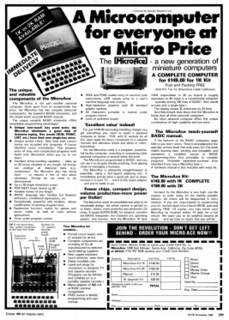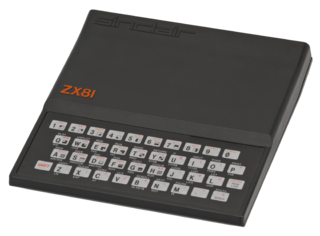 W
WThe Lambda 8300 was a Sinclair ZX81 clone from Lambda Electronics Limited of Hong Kong. It was not an exact clone, as it had a modified ZX81 ROM, but could be fitted with a ZX81 compatible ROM. It came with 2K RAM, and a sound and joystick port. Specifically, it used a Z80A microprocessor at 3.25 MHz. Unisonic distributed it as the Futura 8300 in the US. The computer was somewhat successful in Northern Europe and China, and today enthusiasts still develop new hardware.
 W
WThe MicroAce was a home computer designed and manufactured by CompShop and distributed in the USA by MicroAce of Santa Ana, California,.
 W
WSinclair Programs was a magazine published in the United Kingdom, initially by ECC Publications of London and subsequently by EMAP. It was dedicated entirely to listings for programs for the Sinclair Research ZX80, ZX81 and ZX Spectrum computers, contributed by readers. The magazine was one of three launched in 1982 by ECC, the other two being Sinclair User and Sinclair Projects, the latter dedicated to hardware projects for the Sinclair computers. The magazine was published between May/June 1982 and September 1985.
 W
WThe Timex Sinclair 1000 (TS1000) was the first computer produced by Timex Sinclair, a joint venture between Timex Corporation and Sinclair Research. It was launched in July 1982, with a US sales price of US$99.95, making it the cheapest home computer at the time; it was advertised as "the first computer under $100". The computer was aimed at regular home users. As purchased, the TS1000 was fully assembled and ready to be plugged into home televisions, which served as a video monitor. The TS1000 was a slightly modified version of the Sinclair ZX81 with an NTSC RF modulator, for use with North American TVs, instead of PAL for European TVs. The TS1000 doubled the onboard RAM from 1 KB to 2 KB. The TS1000's casing had slightly more internal shielding but remained the same as Sinclair's, including the membrane keyboard. It had black-and-white graphics and no sound. It was followed by an improved version, the Timex Sinclair 1500 which had substantially more RAM and a lower price (US$80). However, the TS1500 did not achieve market success, given that the marketplace was by this time dominated by Commodore, RadioShack, Atari and Apple.
 W
WTK82C was a Sinclair ZX81 clone made by Microdigital Eletrônica Ltda., a computer company located in Brazil.
 W
WThe TK85 was a ZX81 clone made by Microdigital Eletronica, a computer company located in Brazil. It came with 16 or 48 KB RAM, and had a ZX Spectrum–style case, similar to a Timex Sinclair 1500.
 W
WThe Cambridge Computer Z88 is an A4-size, lightweight, portable Z80-based computer with a built-in combined word processing/spreadsheet/database application called PipeDream, along with several other applications and utilities, such as a Z80-version of the BBC BASIC programming language.
 W
WThe Sinclair ZX80 is a home computer launched on 29 January 1980 by Science of Cambridge Ltd.. It is notable for being one of the first computers available in the United Kingdom for less than a hundred pounds. It was available in kit form for £79.95, where purchasers had to assemble and solder it together, and as a ready-built version at £99.95. The ZX80 was very popular straight away, and for some time there was a waiting list of several months for either version of the machine.
 W
WThe ZX80 character set is the character encoding used by the Sinclair Research ZX80 microcomputer with its original 4K BASIC ROM. The encoding uses one byte per character for 256 code points. It has no relationship with previously established ones like ASCII or EBCDIC, but it is related though not identical to the character set of the successor ZX81.
 W
WThe ZX81 is a home computer that was produced by Sinclair Research and manufactured in Dundee, Scotland, by Timex Corporation. It was launched in the United Kingdom in March 1981 as the successor to Sinclair's ZX80 and designed to be a low-cost introduction to home computing for the general public. It was hugely successful; more than 1.5 million units were sold. In the United States it was initially sold as the ZX-81 under licence by Timex. Timex later produced its own versions of the ZX81: the Timex Sinclair 1000 and Timex Sinclair 1500. Unauthorized ZX81 clones were produced in several countries.
 W
WThe ZX81 character set is the character encoding used by the Sinclair Research ZX81 family of microcomputers including the Timex Sinclair 1000 and Timex Sinclair 1500. The encoding uses one byte per character for 256 code points. It has no relationship with previously established ones like ASCII or EBCDIC, but it is related though not identical to the character set of the predecessor ZX80.